
Châtenay-Malabry (FR - 92290), August 01, 2022
EFITA newsletter / 1050 - European Federation for Information Technology in Agriculture, Food and the Environment
The informatique-agricole.org site offers you the possibility of subscribing the RSS feeds of its two newsletters
See RSS feeds to implement to ensure that you continue to receive this newsletter
To unsubscribe this newsletter, please contact me directely: guy.waksman(a)laposte.net if this link Unsubscribe does not work.

To correspond with me (GW), please use this address: guy.waksman(a)laposte.net
To subscribe the efita newsletter (please ask your friends and colleagues to test this link)
Efita Newsletters subscription
Before computers: Tracteur LATIL, type TR, TRP, et TRPZ (1968 - 1969)
Weekly newsletters about ICT in Agriculture in English and French
Both newsletters have around 14000 subscribers.
>>> Last weekly EFITA Newsletters in English (created in 1999) Efita Newsletters
>>> Last weekly AFIA Newsletters in French (created more than 20 years ago in 1997) Afia Newsletters
>>> Statistics for the last efita newsletter
>>> Last issue of the afia newsletter
>>> Last available satistics for the afia newsletter
Shepherds with their Cattle, by Paulus Potter (NL), 1625–1654, J. Paul Getty Museum, Los Angeles
| 01 - 28/07/22 |  |
Foodtech is the future of food
DigitalFoodLab is a FoodTech insight and strategy consultancy.
Our mission is to look into the future of food and help our clients (brands, retailers and B2B players) stay or become leaders.
See digitalfoodlab.com
Unleashing Innovation: Phase One of Your Endurance Race in Ag Technology
Choosing your specific course is key to surpassing customer expectations and building your brand as you expand into new distances of business growth.
See globalagtechinitiative.com
On the Tay, Perthshire , 1905, Walter J. Watson (British, 1879–1979)
| 02 - 28/07/22 |  |
How did we see the future yesterday??
See the incredible collection developed by Alain Fraval
Soiltech Wireless Completes $2.5M Funding Round to Increase Product Velocity and Advance Sustainability
The new funding will bolster product offerings to support sustainability and value-added traceability.
See globalagtechinitiative.com
CODA Farm Technologies Unveils Updated FarmHQ Device for Remote Monitoring of Irrigation Reels and Pumps
The device includes enhanced cellular connectivity for even better performance in rural areas and an integrated backup battery.
See globalagtechinitiative.com
A milkmaid with Cattle and Chickens, 1902, Caroline Ellen Watson (1871 - 1947)
| 03 - 28/07/22 |  |
How Producing More with Less Will Drive the Future of Agriculture
Ag has become a high-tech industry and that means farmers will require new skills or will need to hire experts in various fields.
See globalagtechinitiative.com
Highland Ag Solutions Celebrates Two Years with Soli Organic
Implementing Highland Hub has helped Soil Organic strengthen food safety culture.
See globalagtechinitiative.com
Five key findings and a data explorer of the UN World Population Prospects 2022
How many people are there in the world? How many die each year, and how many babies are born?
These are key questions that we need to understand the world around us. The global population dataset is one of our most important at Our World in Data: it underpins nearly every topic we cover.
The UN releases an update of its World Population Prospects every two years. Its latest release was due in 2021 but was delayed as a result of the COVID-19 pandemic. But the long-awaited dataset has now been released.
In this article, we highlight some of the key findings. We have also published a new Population and Demography Data Explorer, where you can explore this full dataset in detail, for any country in the world.
| See ourworldindata.org 28/07/22 |
 |
FutureFarming.com
> 12-row weeding robot clears weeds autonomously
Dutch company Andela Techniek & Innovatie is developing a machine for robotic weed removal. A prototype - the 12-row ARW-912 - is running on an organic farm in the Netherlands in carrots and onions. The weeding robot is especially designed for the removal of weeds in the row.
> Crop protection: Nanotechnology to drastically reduce use of weed control chemicals
A group of Brazilian scientists uses nanotechnology to reduce the usage of weed control chemicals by a factor of 80.
> Autosteer: New autosteer system from SingularXYZ
The SingularXYZ SAgro100 autosteer system is new to the Future Farming autosteer retrofit kits catalogue. It is available worldwide from $5,900 / €5,650.
> Field robots: Nexus Robotics receives $2.6 million in grant funding
Nexus Robotics Inc. was awarded $2.6M in grant funding from Sustainable Development Technology Canada (SDTC). The money will be used to develop new weeding robots.
> How safe is farmers’ data if FBN goes public?
Many of the FBN-members share data with each other. How might this data be handled if the company goes public?
> Article: Is Big Data a new input for farming?
> Field trials podcast: Reliable, rapid, and reproducible field data
> Expert opinion: Threats from the cloud – equipment and cyber attacks
> Article: Bungulla Farming reaps the benefits of on-farm data
> News: ADM, Farmers Business Network to expand AgTech platform
> News: Pre-planting weather data determines how much spring nitrogen to apply
See futurefarming.com
Highland calves, Loch Restil, 1918, Caroline Ellen Watson (1871 - 1947)
| 04 - 28/07/22 |  |
Tech has made US beef more productive. It can also make it more sustainable, AFN Sponsored Post
Thanks to advances in technology the US beef industry is more productive than it has ever been, providing more pounds of meat from fewer head of cattle. But that trend of innovation needs to continue if beef producers and industry groups are to meet their sustainability and emissions reduction goals.
That was the message from speakers at the ‘Cattle Feeding 101’ virtual event held by the Beef Alliance last month.
The Beef Alliance – which represents companies responsible for over one-third of the US fed cattle supply – organized the event as an opportunity for entrepreneurs, investors, and other stakeholders to learn about the productivity and sustainability challenges facing the cattle feeding industry:
- The main concentration of US cattle feeding operations remains in the Great Plains, with other significant hubs in the Corn Belt, the Pacific Northwest, and the Southwestern states.
- South Dakota has seen the largest growth in cattle on feed over the past decade, with an increase of 125,000 head (39%).
- Washington has seen the greatest decline, dropping 32,000 head (-13%) over the same period.
- Net monthly US feedlot placements in April 2022 stood at just over 1.7 million head, compared to almost 1.8 million a year previously. Average April net US feedlot placements from 2016 to 2020 were around 1.6 million head.
- Cattle on feed numbers are continuing to go up this year due to ongoing drought in the Western US, which has moved east over the past couple of weeks.
- The overall size of the US feedlot sector by number of operations decreased year-on-year, from just over 28,000 operations in 2020 to 27,000 in 2021; while the size of feed yards continues to increase.
At first glance, some of these figures might lead to conclusions of stagnation; but the data shows that the past few decades have seen significant increases in feedlot productivity.
.../...
See agfundernews.com
New data explorer on democracy
With this explorer we seek to make it easier to access and understand data on democracy. We show and explain data from eight leading democracy datasets: their main measures, indicators of specific characteristics, and global and regional overviews.
You can read more about the approaches — and which democracy measure may be best to answer your questions — in this accompanying article.
| See ourworldindata.org 28/07/22 |
 |
AgroFides is unlocking capital for remote Ghanaian farmers with agrifintech, AFN, by Lucy Ngige
Prince Boateng is a former US naval officer of Ghanaian origin. He worked in the international development field working with the United States Agency for International Development (USAID) under food security and agricultural development-related programs in Africa.
“It struck me that the countries we were working in had fertile ground yet we were shipping food to them,” Boateng tells AFN.
This motivated him to go into the agricultural field seeing that it was also the backbone of many African economies. Together with his co-founders Acheampong Atta-Boateng and Mike Hickey, he founded AgroFides.
AgroFides is an agrifintech startup leveraging AI and agricultural expertise to assess the creditworthiness of small and medium-scaled farmers in Ghana. It is also an intermediary between lenders and farmers to unlock more capital for them.
Like most African countries, Ghana has a large smallholder farmer population, accounting for around 70% of the five million households involved in agriculture.
.../...
See agfundernews.com
Highland Calves, Tay Valley, Perthshire, Carl E. Watson (British)
| 05 - 28/07/22 |  |
Collaboration is key to LatAM AgriFoodTech ecosystem growth, according to GLOCAL panel, AFN Sponsored Post
The Latin American agrifoodtech ecosystem is maturing. In the last few years, Latin America has had exponential growth in the field of innovation as well as in its potential to provide real solutions for the world’s agrifood industry. So much so that during 2021, ‘venture and technology growth investors poured an estimated $19.5 billion into the region,’ and Latin America was the fastest-growing region in the world for venture funding in 2021,’ according to Crunchbase.
It also has a lot more room to grow. Still, more collaboration is needed to maximize the opportunity ahead, agreed participants in a panel organized by GLOCAL, the Latin American agrifoodtech startup investor and accelerator platform. GLOCAL’s GAME CHANGERS final pitch is taking place next week.
More than 120 people worldwide joined the event and had the opportunity to listen to the talk live between GLOCAL and the panelists.
.../...
See agfundernews.com
Future stronger heat waves
|
01 - 28/07/22 |
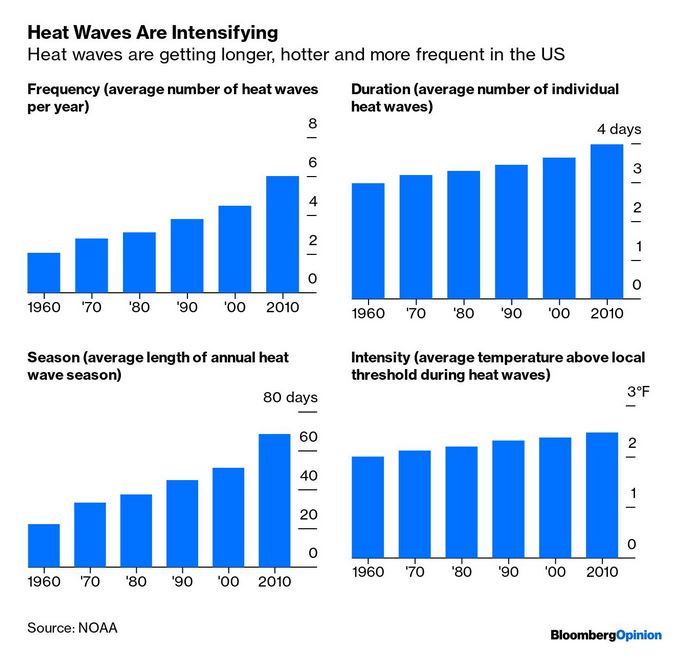 |
Dry Rhine
| 02 - 28/07/22 | 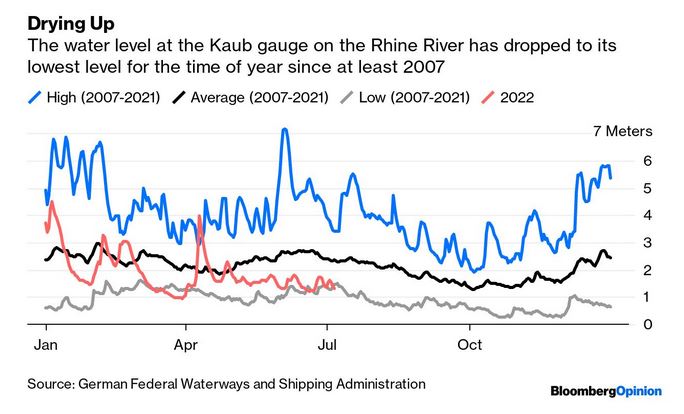 |
How Taimba’s farm-to-retail marketplace, logistics, cold chain & fintech platform is fighting food waste, AFN, by Lucy Ngige
Kenyan B2B agritech startup Taimba is out to help smallholder farmers find markets for their produce by connecting them directly to retailers. It sources fresh agricultural produce with short shelf lives, from rural farmers who often lack proper storage methods, and delivers them to a range of small-scale retailers in Kenya’s capital, Nairobi.
Dominique Kavuisya, CEO and founder of Taimba, created the platform after identifying how much food was wasted in rural parts of the country due to poor food preservation methods and a lack of ready markets around harvest time.
>>> Middlemen and low productivity
Food wastage aside, the smallholders were at the mercy of middlemen who undercut them on pricing for their produce.
“In between [farmers and retailers], you’re looking at five brokers or even more sometimes. There’s a broker who goes to buy from the farmer. Then there’s one who provides the transport. Then, to sell to local markets, there’s a fee one has to pay,” Kavuisya tells AFN.
In turn, end consumers in urban centers have to bear high food costs, while farmers receive meager, delayed payments.
Kavuisya wanted to create a platform that could link rural farmers more directly with buyers, shortening the agricultural supply chain by eliminating these middlemen. And Taimba automates, streamlines, and makes trading transparent so that farmers can follow up on their sales via the mobile app.
“The opportunity was that if you leverage technology in the food supply chain, you’re able to provide a platform that ensures transparency and empowers farmers so that they do not need to worry about where they’re going to sell their produce,” Kavuisya says.
>>> Retailer inconvenience
.../...
See agfundernews.com
Work days at risk, Historical
| 03 - 28/07/22 | 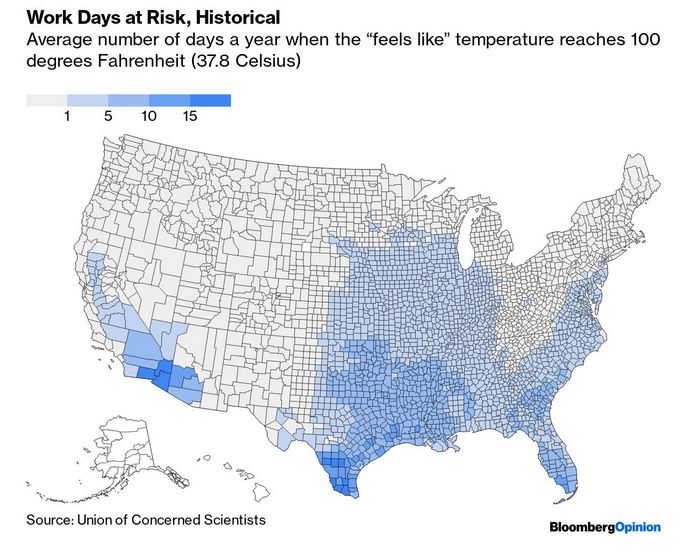 |
Work days at risk, 2050
| 04 - 28/07/22 | 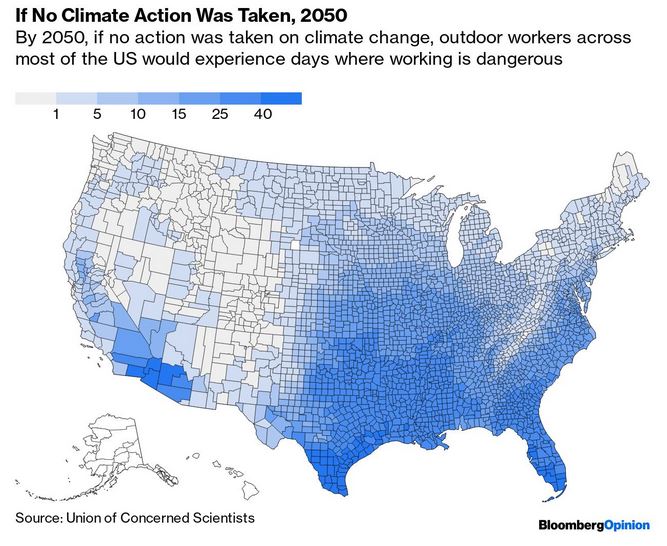 |
Local food isn’t the climate solution you want it to be, GreenBiz, by Theresa Lieb
Local food is better for the environment. That’s one of the most stubborn myths when it comes to sustainable food systems and one of the bubbles I’ve been trying to burst when talking to people about their eating habits. Instead of just shopping local, I’ve been rallying them to think about what they eat (more veg, less meat) and how it’s produced because transport is only responsible for about 6 percent of global food emissions.
Then, earlier this month, Bloomberg reported on a new study published by researchers from the University of Sydney, Beijing Technology and Business University and Wuhan University in the renowned scientific journal Nature Food claiming that food transportation emissions are up to 7.5 times higher than previously estimated. The article also highlighted that "fruits and vegetables are particularly carbon-intensive to ship due to their bulk and the need for refrigeration during transport."
My colleagues and friends loved this news — the article landed in my inbox at least a dozen times. Eating local meat seemed a much more agreeable climate solution than switching to a plant-rich diet. I’m sorry to burst the bubbles once again, but when looking closely at the study’s findings, they don’t support the headline-making statements about the benefits of local food and the drawbacks of eating vegetables.
.../...
See greenbiz.com
Near Mochan, sheep on a mountainside, by William Robert Charles Watson (1873 – 1928)
| 06 - 28/07/22 |  |
Sustainability is here to stay. These two ag agencies are stepping up, by AGDAILY Reporters, July 18, 2022
Amid the ever-evolving challenges of providing a consumer-friendly, sustainable food supply, farmers and food companies often face different pressures while working towards the same end goals. To better accomplish these goals, the United Soybean Board is partnering with The Center for Food Integrity to open conversations and begin collaboration between the two groups.
.../...
According to a 2021 Cargill survey, more than half of consumers on a global scale will choose a package item that boasts a sustainability claim over one that does not. In the U.S., 37 percent of consumers said that sustainability labeling would influence their buying decisions.
To address these issues, the United Soybean Board has partnered with The Center for Food Integrity to begin conversations. Invited to the table are soybean farmers, food sustainability experts, NGOs, academia, and others to a series of virtual round tables and public webinars. These meetings aim to produce a broader understanding of how sustainability can be achieved, the challenges all sides face, and how tradeoffs should be carefully weighed.
Both organizations hope this type of collaboration will help ensure the benefits of modern production practices are understood and considered in food sourcing decisions. The ultimate goal of the collaborations is that farmers and food companies can move forward to protect agriculture’s social license so farmers can continue to use proven practices and technologies and continue to innovate and improve.
See agdaily.com
Cattle on a Cornish coast, William Watson (British, 1831-1921)
| 07 - 28/07/22 |  |
Though inflation
| 05 - 28/07/22 | 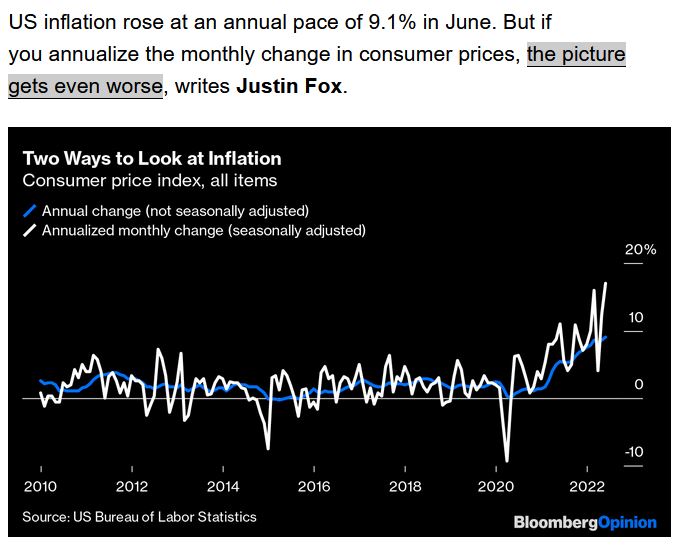 |
The global population is projected to peak at around 10.4 billion in 2086
The world population has increased rapidly over the last century. When will it come to an end?
Previous versions of the UN World Population Prospects showed a significant slowdown in population growth, with very slow growth – almost reaching a plateau – by the end of the century. In its previous release, it projected that the world population would be around 10.88 billion in 2100, and would not yet have peaked.
In this new release, the UN projects that the global population will peak before the end of the century – in 2086 at just over 10.4 billion people.1
There are several reasons for this earlier, and lower, peak. One is that the UN expects fertility rates to fall more quickly in low-income countries compared to previous revisions. It also expects less of a ‘rebound’ in fertility rates across high-income countries in the second half of the century.
| See
ourworldindata.org 28/07/22 |
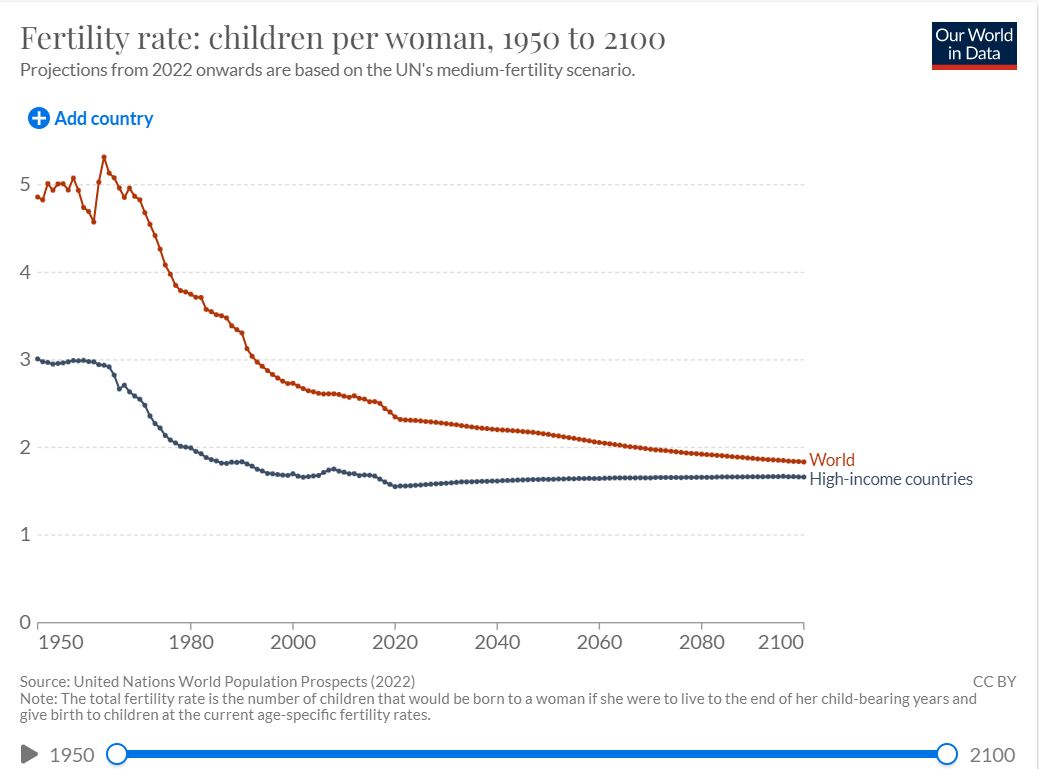 |
The global population is projected to peak at around 10.4 billion in 2086
The world population has increased rapidly over the last century. When will it come to an end?
Previous versions of the UN World Population Prospects showed a significant slowdown in population growth, with very slow growth – almost reaching a plateau – by the end of the century. In its previous release, it projected that the world population would be around 10.88 billion in 2100, and would not yet have peaked.
In this new release, the UN projects that the global population will peak before the end of the century – in 2086 at just over 10.4 billion people.1
There are several reasons for this earlier, and lower, peak. One is that the UN expects fertility rates to fall more quickly in low-income countries compared to previous revisions. It also expects less of a ‘rebound’ in fertility rates across high-income countries in the second half of the century.
| See
ourworldindata.org 28/07/22 |
 |
Strong dollar (1)
| 06 - 28/07/22 | 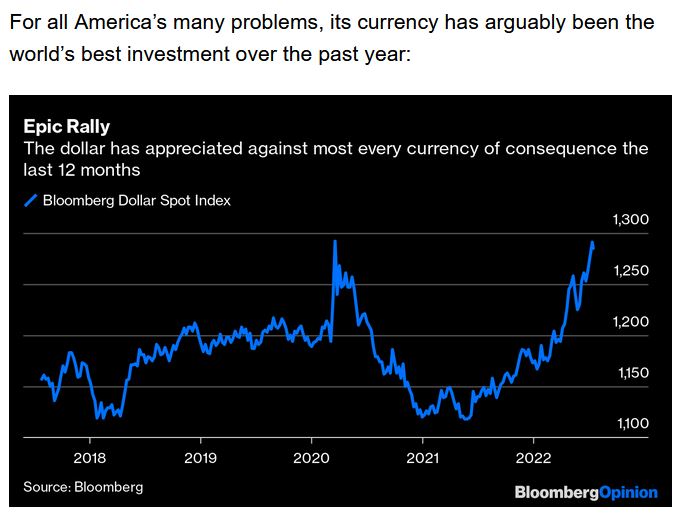 |
Strong dollar (2)
| 07 - 28/07/22 |  |
Apple, the end of one dream?
| 08 - 28/07/22 | 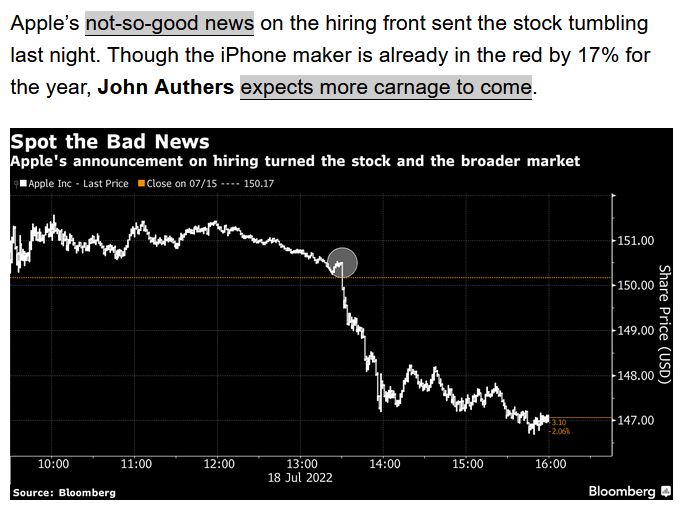 |
A first thought for today
I hold one share in the corporate earth and am uneasy about the management.
E.B. WHITE, writer (1899-1985)
A second thought for today
It is never my custom to use words lightly. If twenty-seven years in prison have done anything to us, it was to use the silence of solitude to make us understand how precious words are and how real speech is in its impact on the way people live and die.
Nelson MANDELA, activist, South African president, Nobel laureate (1918-2013)
A third thought for today
To be able to say how much you love is to love but little.
PETRARCH, scholar and poet (1304-1374)
Chart tracking the prices of US goods and services relative to inflation
|
28/07/22
|
 |
Sri Lanka is a warning against green utopianism
Sri Lanka is in the midst of an unprecedented economic crisis. Inflation has climbed to over 50 percent, and the country fell into a state of emergency after rioters stormed the presidential palace.
One major reason for the collapse was President Rajapaksa’s disastrous fertilizer ban, which devastated Sri Lankan agriculture.
The foolish decision was inspired by an insidious green utopianism that is based on, among other things, a profound ignorance about the causes of human progress against hunger.
See humanprogress.org
On the Machno, North Wales, Walter James Watson (1877 - 1963)
| 08 - 28/07/22 |  |
World's oldest tree still growing near the Norwegian-Swedish border, by Bård Amundsen
The nearly 10 000-year-old spruce tree is only five metres tall, but it began to grow just after the last ice age ended.
Not many years ago, Norwegian schoolchildren learned that spruce trees came to Norway from the east between 2 000 and 3 000 years ago.
But ten years ago, researchers at Umeå University in Sweden discovered a tree up on Fulufjället – in Sweden just east of Trysil municipality in Norway. The tree turned out to be 9 500 years old.
The researchers decided to name the tree after Tjikko, the dog that was with them on the trip when they found the spruce specimen. The tree was thus named Old Tjikko.
New DNA studies carried out by researchers at Uppsala University now show that the very first spruce trees may have come to southern Sweden as early as 14 700 years ago.
In other words, the spruce put down roots here just after the ice from the last ice age had started retreating.
.../...
|
28/07/22
See sciencenorway.no |
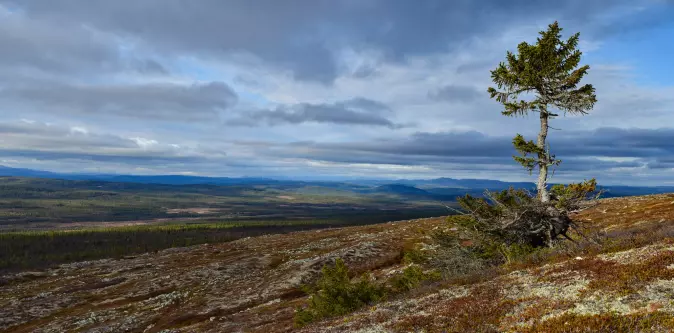 |
|
Gazette
de vitisphere.com, |
A historian identifies the worst year in human history
A Harvard professor's study discovers the worst year to be alive.
- Harvard professor Michael McCormick argues the worst year to be alive was 536 AD.
- The year was terrible due to cataclysmic eruptions that blocked out the sun and the spread of the plague.
- 536 ushered in the coldest decade in thousands of years and started a century of economic devastation.
See bigthink.com
‘Glimmers of hope’ for UK and EU researchers
The three years of UK Prime Minister Boris Johnson’s government “were characterized by a shocking and persistent disregard for rules, for the truth and for expert evidence”, argues a Nature editorial.
His resignation now offers “glimmers of hope” for researchers, if his successor reverses course on some of his policies.
“The government must cease its damaging and ill-considered fights with the scholarly community,” says the editorial.
“It has to stop undermining the autonomy of universities. Political obstacles to UK access to European Union (EU) research funding must be rapidly removed. And a sea change is needed in the United Kingdom’s overall relationship with its European partners.”
See nature.com
GM rice produces 40% more grain
Researchers have given rice a 40% yield boost by introducing a second
copy of a single gene. The gene, known as OsDREB1C, encodes proteins that
control other genes involved in photosynthesis and nitrogen use.
Tweaks to the genetically modified (GM) rice improved photosynthesis,
sped up flowering and helped the plant to absorb nitrogen more efficiently,
resulting in larger, more abundant grains. Researchers say that the same
yield boost could be accomplished by editing the plant’s own genes.
This process tends to be more lightly regulated and is more palatable
to some consumers than transgenic engineering.
See
science.org
Carbon
emissions: the end of European dirty industries?
| 09 - 28/07/22 | 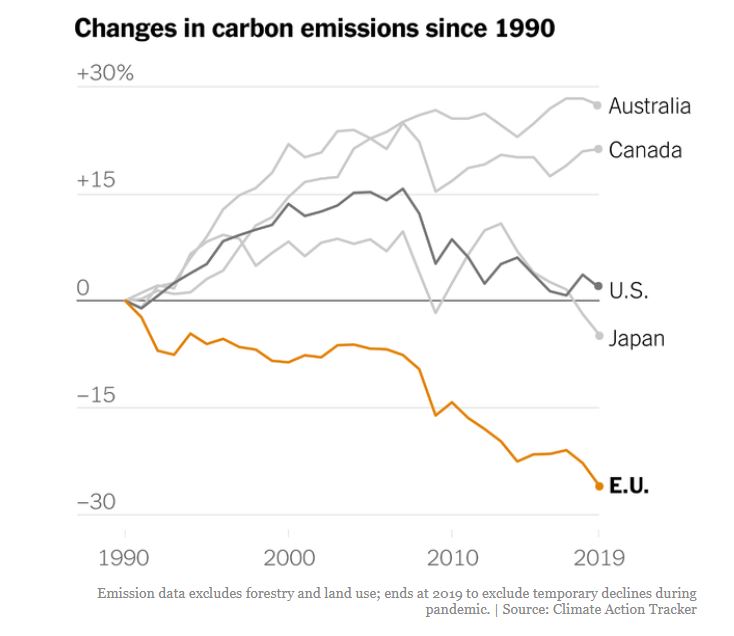 |
In China Property Sales Are Slumping
| 10 - 28/07/22 | 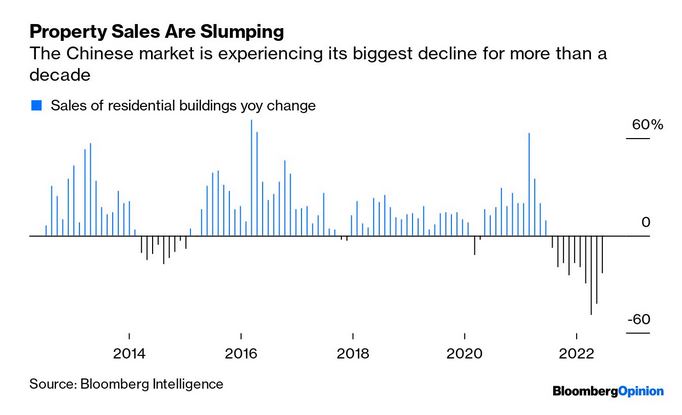 |
Self-driving tractors rolling out in California could fuel the future
of farming, by Jiovanni Lieggi
One of the world's first EV self-driving tractors is being used on farms
in California.
Some California farmers are going a little greener by opting for eco-friendly
tools and transitioning to electric-powered, driverless, tractors. The
company rolling these high-tech tractors out, Monarch Tractor, says this
can help farmers save money, increase production, and help with the agriculture
industry's growing labor shortage.
"It’s sustainability in action and its evolution of the human species,"
fifth-generation winegrower and farmer Karl Wente said. He's been helping
Monarch Tractor test the tractors on his farm. "It used to be a big
tractor where you can see the diesel combusting out, and now you just
have this quiet electric vehicle running through. It's a natural direction,"
Wente explained.
California has nearly 70,000 farms, and farmers produce billions of pounds
of fresh foods every year. Though, every year farmers face challenges,
including record-high inflation rates and worsening drought on the West
Coast. "Mother Nature bats last, and no two seasons are ever the
same," Wente said.
This electric tractor could help with those problems farmers might face,
especially by reducing the overall cost of production and growing, the
company explained.
"Farmers can now save more money by knowing exactly where to target
their resources," Monarch Tractor CEO and Founder Praveen Penmetsa
said.
"What this tractor brings with the whole data side is exactly what’s
been done to the food. Not only that, but the insights on the farming
operations can help farmers to limit their inputs and control their costs,"
Monarch Tractor Co-founder Mark Schwager said.
Rather than having a driver, the tractor has a remote operator who tracks
and receives alerts in real-time. "There is always a human in the
loop," Schwager explained.
.../...
See
foxbusiness.com
Sheep
in winter sunset, Arthur Sydney Watson 1881 - 1931
| 09 - 28/07/22 |  |
Ag conspiracy theories: The imagination of some hurts us all, by Markie Hageman, July 07, 2022
.../...
When our community starts spreading misinformation before asking questions, we are not helping our industry. Isn’t this what we shame consumers and politicians for? Taking something and immediately jumping to conclusions without getting the entire backstory?
We are fearmongering and creating troubles within our industry for no reason. Sometimes bad things happen; sometimes they don’t make sense to us. That doesn’t mean there is something much darker going on. We can, instead, take some of that brain power and put that toward solving the predation problem ranchers face, preventing cattle from enduring heat-stress deaths, and improving the safety of processing plants.
It’s healthy to question everything. It’s also a good rule not to believe everything you read on the internet.
See agdaily.com
Highland calves, Glen Lyon, Perthshire, Arthur Sydney Watson 1881 - 1931
| 10 - 28/07/22 |  |
A dead man's credit
I tried having my mother's phone disconnected, but the customer-service rep told me that since the account was in my dad's name, he'd have to be the one to put in the request.
The fact that he'd been dead for 40 years didn't sway her.
Then a solution hit me:
"If I stop paying the bill, you can turn off the service, right?"
"Well, yes," she said reluctantly. "But that would ruin his credit."
| |
The distribution of this efita newsletter is sponsored by vitisphere.com
Please, contribute to the content of your efita newsletter, and advertise your events, new publications, new products and new project in this newsletter. Without your support, it will not survive!
Contact: Guy WAKSMAN
E-mail: guy.waksman(a)laposte.net
To read this newsletter on our web site
See Efita
The archives of this newsletter
See Efita
Do not miss the Virus Jokes in English and French
About the EFITA mailing list
You can use the efita moderated list (> 15000 subscribers) to announce any event / product / web site / joke (!) related to IT in agriculture, environment, food industry and rural areas.
If you want to subscribe a friend, please fill in his form.
If you do not wish to receive our messages, please fill in the following form...

